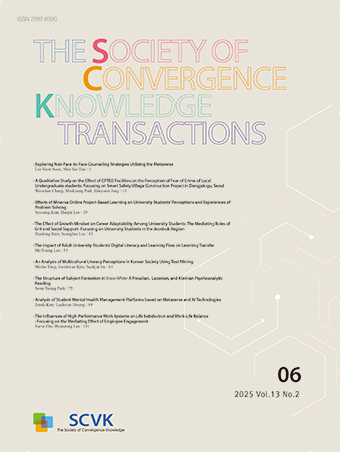Research Article
Abstract
References
Information
본 연구는 중년기 암생존자의 이차암 검진 미수검 관련요인을 분석하기 위해 시도되었다. 제6기, 제7기 국민건강영양조사 자료를 이용하였고, 전체 응답자 39,225명 중 40세 이상 65세 미만의 암생존자 652명을 분석하였다. 수집된 자료는 SPSS 23.0 통계프로그램을 활용하여 기술통계, 카이제곱 검정, 로지스틱 회귀분석을 시행하였다. 연구결과, 중년 암생존자의 이차암 검진 미수검 영향요인은 질병 관련 요인인 규칙적 운동, 활동제한 여부, 흡연, 스트레스를 투입하였을 때 설명력 18.6%로(Hosmer and Lemeshow p-value=0.252, Nagelkerke R2=0.186) 나타났다. 중년 암생존자를 위한 이차암 검진 미수검률은 소인성 요인 측면에서 남성, 농촌 거주자, 사별이나 이혼대상자, 질병 관련 요인 측면에서 평소 스트레스 인지정도가 매우 높은 대상자 일수록 영향력이 큰 것으로 나타났다. 이상의 결과를 토대로 하여, 발생 가능한 이차암의 종류나 발생 빈도, 연령대 별 신체변화 등을 고려한 중년기 암생존자 맞춤형 이차암 검진 가이드라인을 개발해야 할 것이다.
This study was conducted to identify the factors related to secondary primary cancer (SPC) screening practice in middle-aged cancer survivors. The 6th and 7th Korea National Health and Nutrition Examination Survey (KNHANES) data were used and 652 cancer survivors aged 40 and under 65 were analyzed out of 39,225 respondents. The collected data were analyzed using IBM SPSS 23.0 statistical program. The results of the logistic regression analysis, which is the influence of secondary cancer screening in middle-aged cancer survivors, showed that the disease-related factors such as regular exercise, Limitation of general activity, smoking, and stress were 18.6 percent (Hosmer and Lemeshow p-value=0.252 Nagelke R2=0.186). The SPC screening non-practice rate for middle-aged cancer survivors is found to be more influential among men, rural dwellings, people who are widowed or divorced, and those who have a very high level of stress recognition in terms of disease-related factors in terms. The guidelines for SPC screening to cancer survivors in middle age should be developed in consideration of possible types of SPC frequency of occurrence, and body changes by age group.analyze the defective.
- Griffith, K., McGuire, D., and Russo, M., “Meeting Survivors’ Unmet Needs: An Integrated Framework for Survivor and Palliative Care”, Seminars In Oncology Nursing, Vol. 26, No. 4, pp. 231-242, 2010. http://dx.doi.org/10.1016/j.soncn.2010.08.00410.1016/j.soncn.2010.08.00420971404
- National Cancer Center, “2016 KCCR's registered cancer statistics”, 2018.
- National Coalition for Cancer Survivorship, “Defining Cancer Survivorship”, Oxford Dictionaries, 2018.
- Jacobs, L.A., Palmer, S.C., Schwartz, L.A., DeMichele, A., Mao, J., Carver, J. and Meadows, A. T.,“Adult cancer survivorship: evolution, esearch, and planning care”, Cancer Journal for Clinicians, No. 59, pp. 391-410, 2010. 10.3322/caac.2004019897841
- Hewitt, M., Greenfield, S., and Stovall, E.(Eds.), “From cancer patient to cancer survivor: Lost in transition”, Washington DC, 2006.
- Ganz, P.A., “Survivorship: adult cancer survivors”, Primary Care, Vol. 36, No. 4, pp. 721-741, 2009.10.1016/j.pop.2009.08.001 19913184
- Cho, J., Guallar, E., Hsu, Y.J., Shin, D.W., Lee, W.C., “A comparison of cancer, screening practices in cancer survivors and in the general population: The Korean national health and nutrition examination survey (KNHANES) 2001-2007”, Cancer Causes and Control, Vol. 21, No.12, pp. 2203-2212, 2010. http://dx.doi.org/10.1007/s10552-010-9640-4 148,2010. 10.1007/s10552-010-9640-4 21052819
- Travis, L.B., “The epidemiology of second primary cancers”, Cancer Epidemiology Biomarkers and Prevention, Vol. 15, No. 11, pp. 2020-2026, 2006. 10.1158/1055-9965.EPI-06-041417057028
- Park, J.K., Park, H.A., “Screening rates of major cancers after a cancer diagnosis in adults in Korea”, Korean Journal of Health Promotion, Vol. 12, No. 2, pp. 67-74, 2012.
- Tabuchi, T., Ito, Y., Ioka, A., Miyashiro, I., “Tsu Incidence of metachronous second primary cancers in Osaka, Japan: Update of analyses using population-based cancerregistry data”, 2012.10.1111/j.1349-7006.2012.02254.x 22364479
- Yang, Y.H,, “ Influence of Uncertainty and Uncertainty Appraisal on Self-management in Hemodialysis Patients”, Journal of Korean Academy of Nursing, Vol. 44, No. 2, pp. 39-148, 2014.
- Han, J.H., “Review of Rehabilitation Programs for Cancer survivors, Journal of Korea Academia-Industrial cooperation Society”, Vol. 17, No. 12, pp. 307-315, 2016.10.5762/KAIS.2016.17.12.307
- Mols, F., Vingerhoets, A. J., Coebergh, J. W., vandePoll-Franse, L. V., “Quality of life among long-term breastcancer survivors:a systematic review”, European Journal of Cancer, Vol. 41, No. 17, pp. 2613-2619, 2005.10.1016/j.ejca.2005.05.01716226458
- Park, C.L. et al., “Cognitive and emotional aspects of fear of recurrence: predictors and relations with adjustment in young to middle-aged cancer survivors”, Psycho-Oncology, Vol. 22, No. 7, pp. 1630-1638, 2013. 10.1002/pon.319523060271
- Shin, D.W., Cho, J.H., Kim, Y.W., Oh, J.H., Kim, S.W., Chung, K.W., … Lee, W.C., “Efficacy of an Educational Material on Second Primary Cancer Screening Practice for Cancer Survivors: A Randomized Controlled Trial”, PLoS ONE, Vol. 7, No. 3, pp.1-7, 2012. 10.1371/journal.pone.003323822479375PMC3315564
- Park, S.M., Park, C.T., Park, S.Y., Bae, D.S., Nam, J.H., Cho, C.H., et al., “Factors related to second cancer screening practice in disease-free cervical cancer survivors”,Cancer Causes Control, Vol. 20, No. 9, pp. 1697-1703,2009.10.1007/s10552-009-9421-019688183
- Trask, P.C., Rabin, C., Rogers, M.L., Whiteley, J., Nash, J., Frierson, G., et al., “Cancer screening practices among cancer survivors”, Am J Prev Med, Vol. 28, No. 4, pp. 351-356, 2005.10.1016/j.amepre.2005.01.00515831340
- Mayer, D.K., Terrin, N.C., Menon, U., Kreps, G.L., McCance, K., Parsons, S.K., et al. “Screening practices in cancer survivors”. J Cancer Survivor, Vol. 1, No. 1, pp. 17- 26, 2007.10.1007/s11764-007-0007-018648941
- Yang, S.E.., Han, N.K., Lee, S.M., Chung, W.J., “The Factors Related to the Non-Practice of Cancer Screening in Cancer Survivors: Based on the 2007-2012 Korean National Health and Nutrition Examination Survey”, Health Policy and Mangemnet, Vol. 25, No. 3, pp. 162-173, 2015.10.4332/KJHPA.2015.25.3.162
- Wilkins, K.L., Woodgate, R.L., “Preventing second cancers in cancer survivors”, Oncology Nursing Forum, Vol. 35, No. 2, pp. 12-22, 2008.10.1188/08.ONF.E12-E2218321824
- Song, S.H., “Determinant of gastric cancer screening in the Korean population using mullti-level analysis: Korean National Cancer Screening Survey 2011-2012”, Master’s thesis, Yonsei University, 2014.
- Yang, Y.H., “Relationships between knowledge about early detection, cancer risk perception and cancer screening tests in the general public aged 40 and over”, Asian Oncology Nursing, Vol. No.1, pp. 52-60, 2012.10.5388/aon.2012.12.1.52
- Uhlig, A., Mei, J., Baik, I., Uhlig, J., and Meyer, C., “Screening utilization among cancer survivors: a meta-analysis”, Journal of Public Health, Vol. 40, No. 1, pp. 129-137, 2018.10.1093/pubmed/fdx03028334835
- Sung, N.Y., ,Park, E.C., Shin, H.R., Choi, K.S., “Participation Rate and Related Socio-demographic Factors in the National Cancer Screening Program”, Journal of Preventive Medicine and Public Health, Vol. 38, No. 1, 200510.1016/S1359-6349(06)80532-X
- Walsh, B., Siles, M., O’Neill, C., “The Role Of Private Medical Insurance In socio-Economic Inequalities In Cancer Screening Uptake In Ireland”, Health Econ.,Vol. 21, No. 10, pp. 1250-1256, 2012.10.1002/hec.178421905151
- Publisher :The Society of Convergence Knowledge
- Publisher(Ko) :융복합지식학회
- Journal Title :The Society of Convergence Knowledge Transactions
- Journal Title(Ko) :융복합지식학회논문지
- Volume : 7
- No :3
- Pages :135-144
- DOI :https://doi.org/10.22716/sckt.2019.7.3.041




 The Society of Convergence Knowledge Transactions
The Society of Convergence Knowledge Transactions







